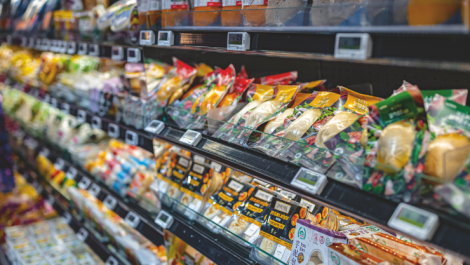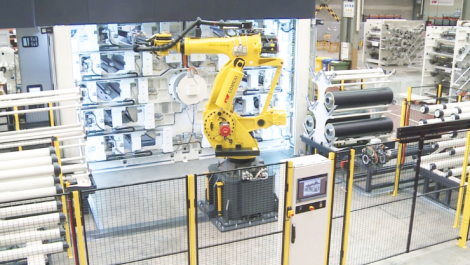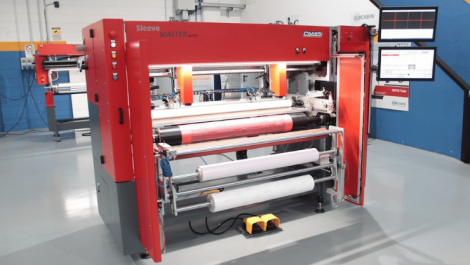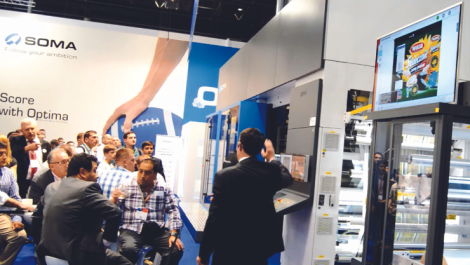The Cast & Cure effects add extra appeal to the magazine
This summer issue of FlexoTech comes with added sparkle. Courtesy of pressroom product specialist CyanX, our cover shines more than usual – a look achieved by using the Cast & Cure process for standout appeal. This is a cost-effective solution that can be added to any existing flexo press.
We all know that to stand out on the busy supermarket shelf, brands are employing a multitude of often quite costly techniques to attract the attention of the consumer. While this magazine is not available off the shelf, we thought it would make sense to use our visibility to show you what can be done if you have the right tools, so when CyanX suggested that we gave the cover a special treatment to make it sparkle, we quickly agreed.
Adding appeal
Cast & Cure is a relatively simple process that allows an etched image to be applied into a UV coating to produce stunning visual effects on the printed sheet. It uses a UV duct varnish applied via a litho plate, which releases an image of a film onto the substrate. The varnish is then cured to create a holographic effect, and the film is delaminated from the surface and rewound for future use. No material is transferred from the film onto the substrate and no varnish is transferred to the film. This allows for multiple uses of the film, which in effect acts as an embossing tool to manipulate the surface of the coating on a submicron scale.
This is a single-pass process that requires only a few hours of operator training. Importantly, it is also environmentally friendly, as it does not eliminate any harmful VOCs or use foil board or other metallised substrates, which are non-recyclable.
Managing director of CyanX, Richard Mawson, said, ‘We have customers who use the film more than 20 times. This is due to the equipment on the press. As the film is re-usable, the handling equipment ideally must be of higher quality than current waste re-winds used with the likes of cold foil units. Saying that, some customers still get four to six uses out of the film this way or by using a laminating unit supplied with the press.’

Web casting units can be manufactured and installed on a wide range of equipment. Narrow and wide web applications are available. Each of these units is custom built to fit the equipment of the individual user. These units are rated to the speed of the existing equipment to ensure a smooth implementation, without hindering the equipment’s current productivity.
The Cast & Cure process can be used for a wide range of applications including pressure sensitive labels, paper and folding carton, plastic and tube materials, and shrink and heat seal films. For narrow web printing, the unit can run inline adapted to the speed of the press, while for wide web, the unit will print offline and re-registering to the printed material.
Models available
Pressroom product supplier CyanX offers specialised cast & cure units and film from Breit Technologies, the Kansas-based global supplier of cast & cure. The Yorkshire-based company was established in 2005 and has found a niche in offering innovative products to printers, helping them gain a competitive edge.
Mr Mawson explained, ‘The Cast & Cure process can be achieved in both sheetfed and web (flexo and gravure) applications. We also provide an offline version that can be used in conjunction with a screen press and a smaller hand-fed tabletop version. The equipment does vary between these applications, but the design is pretty much the same. The most advanced models have the wind/re-wind unit connected through the press controls so normal running speeds, stop/start and safety are not affected.’
The sheetfed equipment is manufactured Foiltone Ltd and these are installed above a print or coating unit depending on the configuration of the donor press.
Breit Technologies manufactures all the web and offline units. These tend to be custom built and can be installed above or at the side of the donor machine depending on the space available.

FlexoTech covers before being sent to Germany for the special treatment
Gaining advantage
The casting films are made from polypropylene and come in 2500 or 5000 metre roll lengths on either 76 mm or 150 mm diameter cores. A standard roll width is 1020 mm, but can be slit down to any size to suit the press. Prices start at around 40p per square metre for the basic designs up to 70p for the more complex or own label films. Custom films can also be manufactured at a competitive price if for instance a whole rebranding of a product is taking place. If such a rebranding involves flexible and carton packaging along with labels, then the cost would be very competitive.
Equipment costs vary between £15,000 from the small tabletop machines up to £150,000 for top of the range combination unit from Foiltone. Depending on the application, the installation takes around three to four days with another couple of days for testing and training. All versions are built to order, and delivery times are usually 8 to 10 weeks from the time of order.
Mr Mawson concluded, ‘We specialise in products that can give printers an advantage in today’s market, where the margins are small and competition fierce. With this technique, flexo printers can offer their customers an expensive looking, high quality finish at a low cost, giving them that value added extra that can make all the difference.’






